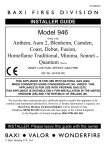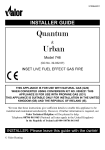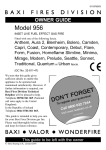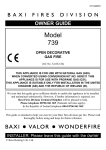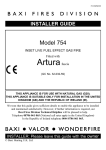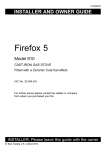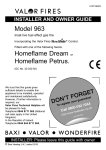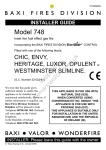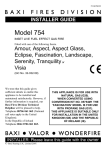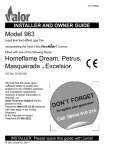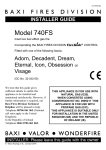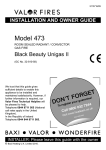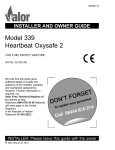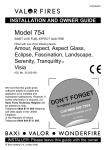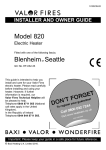Download Model 956
Transcript
5118756/03 INSTALLER GUIDE Model 956 INSET LIVE FUEL EFFECT GAS FIRE Fitted with one of the following fascia. Anthem, Aura 2, Blenheim, Bolero, Camden, Capri, Coast, Contemporary, Debut, Flare, Form, Fusion, Homeflame Slimline, Minima, Mirage, Modern, Prelude, Seattle, Sonnet, Traditional, Quantum or Urban fascia. (GC No. 32-811-47) We trust that this guide gives sufficient details to enable this appliance to be installed and maintained satisfactorily. However, if further information is required, our Baxi Fires Division Technical Helpline will be pleased to help. Telephone 08706 061 065 (National call rates apply in the United Kingdom). In the Republic of Ireland Telephone 0044 8706 061 065. THIS APPLIANCE IS FOR USE WITH NATURAL GAS (G20). WHEN CONVERTED USING CONVERSION KIT NO. 0595221 THIS APPLIANCE IS FOR USE WITH PROPANE GAS (G31). THIS APPLIANCE IS SUITABLE ONLY FOR INSTALLATION IN THE UNITED KINGDOM (GB) AND THE REPUBLIC OF IRELAND (IE). INSTALLER: Please leave this guide with the owner © Baxi Heating U.K. Limited 2007. INSTALLER GUIDE © Baxi Heating U.K. Limited 2007. All rights reserved. No part of this publication may be reproduced in any material form (including photocopying), stored in any medium by electronic means (including in any retrieval system or database) or transmitted, in any form or by any means, whether electronic, mechanical, recording or otherwise, without the prior written permission of the copyright owner. Applications for the copyright owner's permission to reproduce any part of this publication should be made, giving details of the proposed use, to the following address: The Company Secretary, Baxi Heating UK Limited, Pentagon House, Sir Frank Whittle Road, Derby, DE21 4XA. Warning: Any person who does any unauthorised act in relation to a copyright work may be liable to criminal prosecution and civil claims for damages. Baxi Fires Division, Erdington, Birmingham B24 9QP www.firesandstoves.co.uk Because our policy is one of constant development and improvement, details may vary slightly from those given in this publication © Baxi Heating U.K. Limited 2007. Page 2 INSTALLER GUIDE Safety First. Baxi Fires Division fires are CE Approved and designed to meet the appropriate British Standards and Safety Marks. Quality and Excellence. All Baxi Fires Division fires are manufactured to the highest standards of quality and excellence and are manufactured under a BS EN ISO 9001 quality system accepted by the British Standards Institute. The Highest Standards Baxi Fires Division is a member of the Society of British Gas Industries which works to ensure high standards of safety, quality and performance. Careful Installation Baxi Fires Division is a CORGI registered company. All our gas fires must be installed by a competent CORGI Registered Installer in accordance with our Installer Guide and should not be fitted directly on to a carpet or floor of combustible material. © Baxi Heating U.K. Limited 2007. Page 3 INSTALLER GUIDE CONTENTS Section Heading Page 1. SAFETY 2. APPLIANCE DATA 3. GENERAL INSTALLATION REQUIREMENTS 4. PACK CONTENTS 5. FIREPLACE CHECK 6. IGNITION CHECK 7. GAS SUPPLY CONNECTION 8. PREPARING APPLIANCE FOR INSTALLATION 8.3 The flue restrictor. 9. HOTBOX INSTALLATION 10. BURNER INSTALLATION 10.2.1 Lighting the burner. 10.2.2 Operating the burner. 10.3 Inlet pressure check. 11. FULL OPERATING CHECKS 12. FASCIA AND FIREFRONT INSTALLATION 13. SPILLAGE AND FLAME SUPERVISION CHECKS 14. FINAL REVIEW 15. SERVICING AND PARTS REPLACEMENT 15.1 Checking the aeration setting of the burner. 15.2 To remove the burner unit. 15.3 To remove the pilot unit. 15.4 To remove the gas valve. 15.5 To replace the burner. 15.6 To remove the main burner injector. 15.7 To remove the appliance from the fireplace. 15.8 To remove the Quantum, Mirage, Bolero and Urban fascia. 15.9 To remove the magnetic three piece fascia. © Baxi Heating U.K. Limited 2007. Page 4 5 5 7 16 18 20 20 21 21 22 25 25 26 26 27 28 32 34 35 36 36 36 37 38 38 38 38 39 INSTALLER GUIDE 1. SAFETY Installer Before continuing any further with the installation of this appliance please read the following guide to manual handling: ! ! ! ! ! ! ! ! ! The lifting weight of the appliance heat engine and hotbox is 4.4 kg. This does not include fascia or ceramics. One person should be sufficient to lift the fire. If for any reason this weight is considered too heavy then obtain assistance. When lifting always keep your back straight. Bend your legs and not your back. Avoid twisting at the waist. It is better to reposition your feet. Avoid upper body/top heavy bending. Do not lean forward or sideways whilst handling the fire. Always grip with the palm of the hand. Do not use the tips of fingers for support. Always keep the fire as close to the body as possible. This will minimise the cantilever action. Use gloves to provide additional grip. Always use assistance if required. 2. APPLIANCE DATA The efficiency of this appliance has been measured as specified in BS 7977 - 1 and the result is as below : Model 956 Efficiency % (Gross) 51 956 when converted to LPG. 52 The gross calorific value of the fuel has been used for this efficiency calculation. The test data from which it has been calculated has been certified by Advantica Certification services (0087). The efficiency value may be used in the UK Government's Standard Assessment Procedure (SAP) for energy rating of dwellings. The convertion of net efficiency to gross was achieved by multiplying the net efficiency by the following conversion factor from Table E3 of SAP 2005, rounding down to the nearest whole number. Gas Conversion factor from net to gross efficiency Natural Gas 0.901 LPG 0.921 © Baxi Heating U.K. Limited 2007. Page 5 INSTALLER GUIDE This product uses fuel effect pieces and a burner compartment rear wall containing Refractory Ceramic Fibres (RCF), which are man-made vitreous silicate fibres. Excessive exposure to these materials may cause irritation to eyes, skin and respiratory tract. Consequently, it is important to take care when handling these articles to ensure that the release of dust is kept to a minimum. To ensure that the release of fibres from these RCF articles is kept to a minimum, during installation and servicing we recommend that you use a HEPA filtered vacuum to remove any dust and soot accumulated in and around the fire before and after working on the fire. When replacing these articles we recommend that the replaced items are not broken up, but are sealed within a heavy duty polythene bag, clearly labelled as RCF waste. RCF waste is classed as a stable, non-reactive hazardous waste and may be disposed at a landfill licensed to accept such waste. Protective clothing is not required when handling these articles, but we recommend you follow the normal hygiene rules of not smoking, eating or drinking in the work area and always wash your hands before eating or drinking. This appliance does not contain any component manufactured from asbestos or asbestos related products. Gas Inlet Pressure Input - Max. (Gross) Input - Min. (Gross) Inlet Test Pressure (Cold) Gas Connection Burner Injector Pilot & Atmosphere Sensing Device Ignition Aeration Natural (G20) 20mbar 6.0kW (20,500Btu/h) 2.3kW (7,850Btu/h) 20.0 ± 1.0mbar (8.0 ± 0.4in w.g.) Propane (G31) * 37mbar 6.1kW (20,800Btu/h) 3.8kW (12,965Btu/h) 37.0 ± 1.0 mbar (14.85 ± 0.4in w.g.) 8mm pipe Stereomatic Cat 82 - 069 8mm pipe Stereomatic Size 128 Copreci Ref. O.D.S 21500/166 Fitted with RBM 180 - 02 injector Copreci Ref. O.D.S 21500/166 Piezo Electric. Integral with Piezo Electric. Integral with Gas Tap Gas Tap See section 15.1 Non-adjustable * When converted using Kit 0595221. The appliance data label is located on a plate at the base of the fire. This can be seen by removing the firefront casting set / firefront. © Baxi Heating U.K. Limited 2007. Page 6 INSTALLER GUIDE 3. GENERAL INSTALLATION REQUIREMENTS 3.1 The installation must be in accordance with these instructions. For the user’s protection, in the United Kingdom it is the law that all gas appliances are installed by competent persons in accordance with the current edition of the Gas Safety (Installation and Use) Regulations. Failure to install the appliance correctly could lead to prosecution. The Council for the Registration of Gas Installers (CORGI) requires its members to work to recognised standards. In the United Kingdom the installation must also be in accordance with: All the relevant parts of local regulations. All relevant codes of practice. The relevant parts of the current editions of the following British Standards: BS EN 1856 Part 1 which replaces BS 715 BS EN 1858 which replaces BS 1289 Part 1 BS EN 1806 which replaces BS 1289 Part 2 BS EN 1856 Part 1 which replaces BS 4543 Part 2 BS 5440 Part 1 BS 5440 Part 2 BS 6461 Part 1 BS 1251 BS 5871 Part 1 BS 6891 In England and Wales, the current edition of the Building Regulations issued by the Department of the Environment and the Welsh Office. In Scotland, the current edition of the Building Standards (Scotland) Regulations issued by the Scottish Executive. In Northern Ireland, the current edition of the Building regulations (Northern Ireland) issued by the Department of the Environment for Northern Ireland. In the republic of Ireland the installation must be carried out by a competent person and installed in accordance with: a) The current edition of IS 813 “Domestic gas installations”. b) All relevant national and local rules in force. c) The current building regulations Where no specific instructions are given, reference should be made to the relevant British Standard Code of Practice. 3.2 In the United Kingdom, as supplied, this appliance can be installed in the following situations: 3.2.1 A masonry chimney with a minimum diameter of 175mm (7”) free from any obstruction, and with any damper or restrictor plate in the chimney removed or secured, © Baxi Heating U.K. Limited 2007. Page 7 INSTALLER GUIDE and having a minimum effective flue height of 3m (10ft). A masonry chimney having a See Section 3.14 correctly installed flue liner to BS EN 1856 Part 1 or BS715 and with a minimum flue diameter of 125mm is also acceptable. Chair brick removal may not be required providing at least 50mm clearance is available from the flue outlet to any fireplace component. The appliance is designed to Figure 1. Hearth and fireplace opening dimensions (See cater for low lintel installations (min height section 3.2.1.1) 505mm) providing a minimum distance of 25mm is maintained between the lintel and the front face of the fireplace (i.e. 25mm rebated fire surround). 3.2.1.1 ‘Hole-in-the-wall’ Installations ! It is recommended that a hearth should be installed as in section 3.9 (See figure 1). ! If no hearth or a reduced depth hearth is fitted, the fire must be installed so that the distance from the base of the fireplace opening in the wall to the finished floor level is at least 72mm. Where there is no floor covering or carpet and the floor is of a type that is likely to be covered in such a way in the future then the distance from the base of the fireplace opening in the wall to the finished floor level should be increased to at least 147mm. ! If the lower part of the fascia (the firefront) is free standing, the recommended reduced hearth depth is 100mm. This is necessary to support the firefront (See figure Figure 2. Metal flue box © Baxi Heating U.K. Limited 2007. Page 8 INSTALLER GUIDE 5 for appliance dimensions). ! To protect from the risk of burns and ignition of clothing a tactile separator shall be used. The hearth detailed in section 3.9 meets the requirements for a tactile separator. If this is not used then a 625mm long fender, kerb, horizontal bar, or other barrier, being fixed not less than 50mm above floor level and positioned 300mm in front of the fixing plane of the fire will meet the requirement. 3.2.2 To a fireplace incorporating a metal flue box conforming to BS EN 1856 Part 1 or BS715 with a minimum internal depth of 150mm. Incombustible mineral wool insulation of not less than 50mm thickness must be applied to the top surface of the firebox (See figure 2) and it must stand on a non-combustible hearth (See figure 1). 3.2.3 To a fireplace that has a precast concrete or clay flue block system conforming to BS1289 or BS EN 1858. The appliance is suitable for installations conforming to older versions of BS1289 as well as the current edition. The flue blocks must have a minimum width not less than 63mm and a cross-sectional area not less than 13,000mm2. Older editions of BS1289 required a crosssectional area of 13,000mm2. The current revision of the standard requires 16,500mm2. This appliance is suitable in both cases. The total depth of the opening measured from the finished front of the fireplace (Including plaster, surround etc.) must be not less than 120mm (See figure 3). The current versions of BS1289 and BS EN 1858 recommend that there should be Figure 3. Pre-cast fireplace an air space or insulation between the flue blocks and the plaster because heat transfer may cause cracking on directly plastered flues. However, generally this appliance is suitable for installations under all circumstances unless there is a history of cracking problems. Remember that faults such as cracking may be caused by poorly built and restrictive flues, e.g. mortar extrusions, too many bends, flue heights below © Baxi Heating U.K. Limited 2007. Page 9 INSTALLER GUIDE three metres, restrictive terminations, etc. 3.2.4 If the fireplace opening is greater than the acceptable dimensions given in this guide, do not use the back of a fire surround or marble to reduce the opening. This may cause cracking of the surround back or marble. 3.3 The following flues are suitable: ! 225mm x 225mm conventional brick flue. If a flue liner is used, it must be a minimum of 125mm diameter. The liner must be sealed to the surrounding area above the fireplace opening and to the top of the chimney. An approved terminal must be fitted. ! A properly constructed precast flue conforming to B.S 1289 or BS EN 1858. ! A flue pipe with a minimum diameter of 127mm. See B.S 6461 Part 1 for suitable materials. Metal flue pipes must comply with BS EN 1856 Part 1 or B.S 715. 3.3.1 The minimum effective height of the flue must be 3m. 3.3.2 The flue must be clear of any obstruction and its base must be clear of debris. 3.3.3 The flue must be completely sealed so that combustion products do not come into contact with combustible materials outside the chimney. 3.3.4 The flue must serve only one fireplace. 3.4 The flue must conform to BS 5440: Part 1 in design and installation. The flue, measured from the bottom of the fireplace opening to the bottom of the terminal, shall be not less than 3m in actual vertical height. When calculated in accordance with BS 5440: Part 1 Annex A, the minimum equivalent height of the flue shall be 2.0m of 125mm dia. flue pipe. 3.5 The flue must not be used for any other appliance or application. 3.6 Any chimney dampers or restrictors should be removed. If removal is not possible they must be fixed in the open position. 3.7 If the appliance is intended to be installed to a chimney, which was previously used for solid fuel, the flue must be swept clean prior to installation. All flues should be inspected for soundness and freedom from blockages. 3.8 If the fireplace opening is an underfloor draught type, it must be sealed to stop any draughts. 3.9 The appliance must be mounted behind a non-combustible hearth (N.B. conglomerate marble hearths are considered as non-combustible) unless the conditions of section 3.2.1.1 are met. The appliance can be fitted to a purpose made proprietary class “O”-150°C surround. The hearth material must be at least 12mm thick. The periphery of the hearth (or fender) should be at least 50mm above floor level to © Baxi Heating U.K. Limited 2007. Page 10 INSTALLER GUIDE discourage the placing of carpets or rugs over it. The appliance must not stand on combustible materials or carpets (See figure 1). 3.10 The front face of the fireplace should be reasonably flat over the area covered by the hotbox top and side flange seals to ensure good sealing. These faces should be made good if necessary. The fireplace floor should be reasonably flat to ensure that a good seal with the hotbox can be made. 3.11 Note that soft wall coverings (e.g. embossed vinyl, etc.) are easily affected by heat. They may scorch or become discoloured when close to a heating appliance. Please bear this in mind when installing. 3.12 The appliance must not be installed in any room, which contains a bath, or shower or where steam is regularly present. 3.13 An extractor fan may only be used in the same room as this appliance, or in any area from which ventilation for the appliance is taken, if it does not affect the safe performance of the appliance. Note the spillage test requirements detailed further on in this manual. If the fan is likely to affect the appliance, the appliance must not be installed unless the fan is permanently disconnected. 3.14 The minimum height from the base of the fireplace opening to the underside of any shelf made from wood or other combustible materials is detailed below. • For a shelf up to 150mm deep: Minimum height = 750mm. • For a shelf deeper than 150mm: 750mm + 12.5mm for every 25mm depth over 150mm (See Graph 1). Graph 1. Combustible shelf clearances © Baxi Heating U.K. Limited 2007. Page 11 INSTALLER GUIDE 3.15 Normal adventitious ventilation is usually sufficient to satisfy the ventilation requirements of this appliance. In GB reference should be made to BS 5871 Part 2 and in IE reference should be made to the current edition of IS 813 “Domestic gas Installations” which makes clear the conditions that must be met to demonstrate that sufficient ventilation is available. 3.16 Propane gas appliances must not be installed in a room, which is built entirely below ground level (See BS 5871 Pt2). 3.17 If the appliance is to be fitted against a wall with combustible cladding, the cladding must be removed from the area covered by the fascia. The cladding must also not touch the fascia (See figure 4). We suggest that the actual fascia is used as a template to mark the area for combustible cladding removal and that this area is increased by at least 2mm all round. 3.18 The minimum allowable distance from the outside of the appliance fascia to a corner wall having combustible material or any other combustible surface which projects beyond the Figure 4. Removal of combustible cladding (Fascia may differ from that front of the appliance is shown in figure 5. shown) Figure 5 also gives the necessary access clearance from a non-combustible surface at both sides. 3.19 Proprietary terminals must comply with BS 715 or BS 1289. Any terminal or termination must be positioned in accordance with BS 5440 Part 1 to ensure that the products of combustion can be safely dispersed into the outside atmosphere. Where the appliance is connected to an unlined brick chimney it is generally unnecessary for the chimney pot to be replaced or for a terminal to be fitted unless the flue has a diameter smaller than 170mm. 3.20 The appliance is fitted with an A.S.D (Atmosphere sensing device). If the appliance closes down after a period of operation for no apparent reason, the consumer should be informed to stop using the appliance until the installation and appliance have been thoroughly checked. The A.S.D will shut the appliance down if an unacceptable amount of harmful products of combustion accumulate. Under no circumstances should the A.S.D be altered or bypassed in any way. Only a genuine manufacturers replacement part should be fitted. The individual A.S.D components are not replaceable. © Baxi Heating U.K. Limited 2007. Page 12 INSTALLER GUIDE 3.21 A fireguard complying with BS 8423 should be fitted for the protection of young children, the elderly, the infirm or pets. © Baxi Heating U.K. Limited 2007. Page 13 INSTALLER GUIDE Figure 5. Appliance dimensions and clearances (Fascia may differ from that shown) (The appliance dimensions ‘A’, ‘B’ & ‘C’ shown in the table are subject to manufacturing tolerance) © Baxi Heating U.K. Limited 2007. Page 14 INSTALLER GUIDE Key A Model B C Depth Height Width into (mm) (mm) room (mm) D E Minimum mandatory Recommended clearance to clearance to noncombustible combustible surfaces surfaces projecting for access purposes beyond the front of (mm). appliance (mm). Blenheim, Homeflame Slimline, Sonnet & Traditional. 587.5 450 85 100 10 Aura 2, Camden, Contemporary, Form, Modern & Seattle. 587.5 450 63 100 10 Coast 587.5 450 55 100 10 Anthem 585 450 68 100 10 Quantum 600 500 (includ -ing plinth) 80 100 50 (From fascia sides, not plinth) Minima, Debut & Prelude. 585 450 76 100 10 Urban & Mirage. 600 467 57 100 50 Bolero 636 518 94 100 10 Fusion 592 450 67 100 10 Flare & Capri 587.5 450 © Baxi Heating U.K. Limited 2007. 105 100 10 Page 15 INSTALLER GUIDE 4. PACK CONTENTS Remove all the items carefully to prevent damage. Take special care when handling the ceramic components. Some items may be contained in the packaging fitments Examine the packaging carefully before discarding. Check that all the items are present and undamaged. Items below with a letter reference are supplied on a film wrapped card. 1 4 6 2 2 1 2 1 1 4 4 Loose parts pack including: ‘A’ screws (No.8 x 6) ‘B’ screws (No. 8 x 10) ‘C’ screws (M4 x 10) ‘D’ screws (M5 x 10) ‘E’ Quantum fascia hanging bracket. ‘F’ Cable adjusters ‘G’ Inlet ‘T’ connector / elbow including pressure test point, nut and olive. ‘H’ Grommet for rear of hotbox. ‘I’ Wall fixing plugs ‘J’ Screweyes. 1 1 1 2 1 1 1 1 1 Hotbox and burner assembly Burner tray trim (Supplied with all 956 models but NOT to be fitted to the ‘Anthem’. Length of self-adhesive foam seal Tension cables Flue restrictor Strip of floor sealing tape Ceramic fuel effect Fascia / Fascia & firefront Literature pack. Figure 6. Pack contents (Not all of the components listed may be required) © Baxi Heating U.K. Limited 2007. Page 16 INSTALLER GUIDE Figure 6. Pack contents continued. © Baxi Heating U.K. Limited 2007. Page 17 INSTALLER GUIDE Figure 6. Pack contents continued. 5. FIREPLACE CHECK 5.1 Fireplace check. 5.1.1 Fireplace size The fireplace must comply with the requirements described in section 3.2. This may entail removing the fireback and infill material behind the fireback. 5.1.2 Fireplace general condition The fireplace floor should be reasonably flat to ensure that the hotbox can be installed without it rocking and so that a good seal can be made at the bottom front of the box. The front face of the fireplace should be reasonably flat over the area covered by the hotbox top and side flange seals to ensure good sealing. These faces should be made good if necessary. If the appliance is to be fitted against a wall with combustible cladding, the cladding must be removed from the area covered by the fascia. The cladding must also not touch the fascia (See figure 4). We suggest that the actual fascia is used as a template to mark the area for combustible cladding removal and that this area is increased by at least 2mm all round. © Baxi Heating U.K. Limited 2007. Page 18 INSTALLER GUIDE 5.1.3 Soundness for appliance attachment Two primary methods of retaining the appliance are provided: 1) By fixing to the fireplace front surround. 2) Using concealed tension cables fixed to the rear of the fireplace opening. The methods are detailed in section 9 of this manual. Before selecting the retention method, consult with the customer. Method 2 is provided for instances where drilling holes in the front surface of the fireplace surround is unacceptable to the customer or otherwise impractical. N.B. It is unwise to attempt to drill into marble without the proper tools and equipment. If method 1 is chosen, make sure that the front surround area is sound enough to take the wall plugs and screws. If necessary, make sound with a suitable cement. If method 2 is chosen, make sure that the areas at the back and towards the centre of the fireplace floor are sound enough to take the eyescrews. If these areas have deteriorated due to prolonged use, they should be made sound with a suitable cement. 5.1.4 Installations using a metal flue box The whole of the top surface of the metal flue box must be covered with a minimum 50mm layer of mineral wool or equivalent insulation (See figure 2). 5.2 Fireplace flue pull. Close all doors and windows in the room in which the appliance is to be installed. After confirming with a match that smoke is drawn into the flue, light a 13 gram smoke pellet and check that there is a definite flow through the flue. Verify outside that the smoke exits from one terminal only and that the termination is suitable. Observe where possible, upstairs rooms and loft spaces for signs of escaping smoke indicating a defective flue. If there is not a definite flow warm the flue for a few minutes and repeat the smoke pellet test. If there is still no definite flow the flue may need remedial work – Do not fit the appliance until there is a definite flow through the flue. © Baxi Heating U.K. Limited 2007. Page 19 INSTALLER GUIDE 6. IGNITION CHECK Before attempting to install, it is worth checking that the ignition system performs satisfactorily. ! Set the control knob to the ‘OFF’ position. ! Depress the control knob and rotate it anticlockwise to the ‘pilot ignition’ position. A 'click' will be heard as the integral piezo operates. A spark should be seen between the electrode and pilot tip. If there is no spark check the following: ! Ensure that the electrode lead is connected to the terminal at the base of the electrode. ! If the above is correct, check for damage to the electrode lead. Figure 7. Ignition operation 7. GAS SUPPLY CONNECTION A nut and olive are provided for an 8mm pipe inlet connection to the inlet elbow at the bottom front of the appliance. The inlet elbow can be rotated to allow a connection from any direction. The inlet elbow includes a valve for isolating the gas supply and a pressure test point. The supply pipe must be rigid material. Flexible pipe must not be used. Concealed supply pipe connection. If a concealed connection from inside the fireplace is required then, before the appliance is fitted into the fireplace it will be necessary to extend the supply line so that it will project through the hole in the back of the hotbox and run to the inlet elbow at the front. The pipe run from the supply line up to the rear opening in the hotbox must be kept away from the area which will be taken by the hotbox when it is installed. Note that the centre of the appliance inlet elbow is 25mm above the fireplace floor. The inlet elbow should be fitted to the supply pipe at this stage. © Baxi Heating U.K. Limited 2007. Page 20 INSTALLER GUIDE 8. PREPARING APPLIANCE FOR INSTALLATION 8.1 Appliance preparation. 1. Remove any transit tape and packing and inspect for any evidence of mishandling which might affect the performance of the fire. Each unit is flame tested before it leaves the factory and as a result there may be slight discolouration around the burner ports. 2. Detach the burner unit from the hotbox by removing two screws (See figure 8). Lift the burner unit clear. Figure 8. Burner attachment points IMPORTANT Before continuing with the installation of this gas fire the aeration setting on the burner must be checked. The aeration is factory set, but will require adjustment (See section 15.1). 3. It is important that the grommet ‘H’ supplied in the loose parts pack is fitted to the hole in the rear of the hotbox. 8.2 Fitting the foam seal (All models). There is a length of self adhesive foam seal supplied with the fire. This will need to be fitted to the outer rear edges of the side and top flanges of the hotbox. Cut the foam seal to the required length. Be careful not to stretch the seal when measuring. Remove the protective backing from the foam seal and fit this to the rear of the hotbox flange (See figure 9). 8.3 The flue restrictor. This appliance is supplied with a flue restrictor for use where the flue draught is excessive. The restrictor must not be fitted where a precast flue or a 125mm flue liner is used. For flue liners greater than 125mm and all other installations the restrictor should be fitted. There may however, be certain exceptional Figure 9. Fitting the foam seal circumstances where fitting the restrictor causes the fire to fail the spillage test. In such cases the restrictor will have to be removed. © Baxi Heating U.K. Limited 2007. Page 21 INSTALLER GUIDE After removal conduct the spillage check again. The restrictor is packed flat with the appliance and will require bending prior to fixing. Bend the restrictor as shown in figure 10. Fit the restrictor as shown in figure 11 using the two ‘B’ screws provided. 8.4 Fitting the Quantum fascia hanging bracket. 1. Supplied in the loose parts pack is a fascia hanging bracket ‘E’. Fit this to the top of the hotbox using two of the ‘A’ screws supplied. (See figure 12). Figure 10. Bending the restrictor Figure 11. Fixing restrictor Figure 12. Quantum fascia bracket. 9. HOTBOX INSTALLATION 9.1 Method 1- Front fixing to fireplace surround 1. Make sure that the fireplace front surround area is sound enough to take the wall plugs and screws. If necessary, make sound with a suitable cement. 2. Place the hotbox centrally in the fireplace in the position in which it is to be permanently installed. If a concealed connection is being used, insert the hotbox into the fireplace feeding the supply pipe through the pierced hole in the rear seal. 3. Mark the fireplace front surround through the four fixing holes in the side flanges of the hotbox (See figure 13). 4. Remove the hotbox. Drill four holes in the fireplace front surround at the marked positions using a no.12 masonry drill. 5. Insert a wall plug ‘I’ into each hole. © Baxi Heating U.K. Limited 2007. Page 22 INSTALLER GUIDE 6. Place the hotbox back in position in the fireplace. 7. Fit a suitable screw (Not supplied) through each hole in the hotbox flanges and tighten to seal the box to the fireplace surround. We recommend the use of a screw with 1 1/2 inches (38mm) length. 9.2 Cable retention. 1. Make sure that the relevant areas at the fireplace back are sound enough to take the eyescrews. If these areas have deteriorated due to prolonged use they should be made sound with a suitable cement. 2. Drill four holes in the rear wall of the fireplace for the fibre plugs. The holes should be drilled within the range of positions shown in figure 14 using a no.12 masonry drill. The holes should be equidistant each side of the centre line of the fireplace to ensure that the appliance Figure 13. Front Fixing finishes centrally in the opening when tension is applied to the cables. 3. Insert a fibre wall plug ‘I’ into each hole. Use the fibre wall plugs supplied with this appliance - Never use plastic plugs instead of the fibre plugs supplied. Screw the eyescrews ‘J’ into the plugs. Make sure that the Figure 14. Eyebolt positions eyescrews are secure. 4. Place the hotbox unit close to the fireplace but allow sufficient access into the fireplace opening so that the cables can be threaded through the eyescrews and returned through the back of the hotbox. If a concealed connection is being used, insert the hotbox into the fireplace feeding the supply pipe through the pierced hole in the rear grommet. 5. The rear of the hotbox has a slot and hole each side of the outlet opening. Assemble one end of the cable to the top of the fire by passing it through the small Figure 15. Upper cable retention round hole and locking by positioning the cable in the © Baxi Heating U.K. Limited 2007. Page 23 INSTALLER GUIDE adjacent slot (See figure 15). Give the cables a pull so that they grip. 6. Thread the cables through the eyescrews. Return the cables through the holes near the bottom of the hotbox side panels (See figure 16). 7. Place the hotbox fully back into the fireplace opening so that it is sealed against the fireplace front surround. 8. Fit a cable adjuster ‘F’ over the bottom end of each cable. 9. Pull each cable taut. Push the cable adjusters hard up against the back panel. Tighten the screws in the adjusters so that they clamp the cables in position. Apply tension to Figure 16. Cable route the cables by turning the hexagonal adjusters by hand (See figure 17). 10. Inspect the installation of the hotbox against the fireplace surround. If the hotbox is aligned squarely and the sealing is satisfactory, fully tighten the cable adjusters. 11. If the hotbox is not correctly aligned, release the tension on the cables by slackening the screws and turning the hexagonal adjusters fully anticlockwise. The hotbox should then automatically realign itself. Pull each cable taut again and push the cable adjusters back against the back panel. Again, tighten the screws in the adjusters and apply tension to the cables by turning the hexagonal adjusters clockwise as far as possible. 12. Do not cut off any excess cable, instead coil up the cable so that they are available to allow easy removal and refitting of the appliance during subsequent service calls. Figure 17. Lower cable retention © Baxi Heating U.K. Limited 2007. Page 24 INSTALLER GUIDE 9.3 Floor sealing. Using the floor sealing tape supplied, seal the bottom of the hotbox to the fireplace and hearth floor. Run the tape over the centre bracket (See figure 18). Figure 18. Floor sealing 10. BURNER INSTALLATION 10.1 Burner and supply pipe installation. 1. Refit the burner unit to the hotbox using the two screws removed previously. The burner securing points should be on the inside of the hotbox as shown in figure 19. 2. Connect the supply line to the appliance. 3. If closed, open the isolating valve at the inlet elbow. 4. Turn on the gas supply and pressure check Figure 19. Burner attachment points the installation pipework for gas soundness. In the United Kingdom check in accordance with the current edition of BS 6891. In the Republic of Ireland refer to the current edition of I.S. 813 “Domestic gas installations”. 10.2.1 Lighting the burner. 1. Depress the control knob and rotate it anticlockwise to the ‘pilot ignition’ position. A 'click' will be heard as the integral piezo operates. A spark should be seen between the electrode and pilot tip. 2. Turn the control knob clockwise to the 'OFF' position. Repeat this operation until a flame appears at the pilot. There may be a delay before the pilot lights due to air being purged from the system. When a flame appears at the pilot keep the control knob depressed and hold the pilot ignition position for ten seconds. When the control knob is released the pilot flame should remain lit. © Baxi Heating U.K. Limited 2007. Page 25 INSTALLER GUIDE 10.2.2 Operating the burner. 1. When the pilot burner is operating properly, gradually turn the control knob anticlockwise to 'HIGH' (Depress the knob slightly to get past the ‘pilot ignition’ position). The main burner should now light. Depress the control knob slightly to release from the 'HIGH' position and turn back (clockwise) to 'LOW'. While turning, the burner flames should gradually become lower but remain alight. Depress the control knob slightly to release from the 'LOW' position and turn back (clockwise) to the Pilot ignition position. The main burner should extinguish but the pilot should remain alight. Depress the control knob slightly and turn back (clockwise) to turn OFF. This will extinguish the pilot. If the above checks are satisfactory, continue with the installation. If not, check the control and ignition circuitry and components. 10.3 Inlet pressure check. The appliance is pre-set to give the correct heat input at the inlet pressure shown in section 2 of this manual. No adjustment is necessary. 1. Check the inlet pressure by fitting a pressure gauge at the test point. The test point is on the inlet elbow (See figure 20). Check the pressure with the appliance alight and set at maximum output. 2. After checking, turn off the appliance. Remove the pressure gauge and replace the test point sealing Figure 20. Pressure test point screw. 3. Relight the appliance. Turn to the maximum output position and test around the sealing screw for gas soundness with a suitable leak detection fluid. 10.4 Fitting the burner tray trim (This is supplied with all models but must NOT be fitted to the Anthem model). 1. Fit the burner tray trim over the front rim of the burner tray. Push the trim fully down (See figure 21). Figure 21. Burner tray trim © Baxi Heating U.K. Limited 2007. Page 26 INSTALLER GUIDE 11. FULL OPERATING CHECKS 11.1 Check the control settings. With the ceramic fuel effect in position the control operation must now be fully rechecked. Make sure that the isolating valve at the inlet elbow is open. ! When first turned on from cold, the flames will appear predominantly blue. ! When operating the fire for the first time, some vapours may be given off which could set off smoke alarms in the vicinity. These vapours are quite normal with new appliances. They are totally harmless and will disappear after a few hours use. 11.1.1 Lighting the burner. 1. If closed, open the isolating valve at the inlet elbow. 2. Depress the control knob and rotate it anticlockwise to the pilot ignition position. A 'click' will be heard as the integral piezo operates. A spark should be seen between the electrode and pilot tip. 3. Turn the control knob clockwise to the 'OFF' position. Repeat this operation until a flame appears at the pilot. There may be a delay before the pilot lights due to air being purged from the system. When a flame appears at the pilot keep the control knob depressed and hold the pilot ignition position for five seconds. When the control knob is released the pilot flame should remain lit. 11.1.2 Operating the burner. 1. When the pilot burner is operating properly, gradually turn the control knob anticlockwise to 'HIGH' (Depress the knob slightly to get past the pilot ignition position). The main burner should now light. Depress the control knob slightly to release from the 'HIGH' position and turn back (clockwise) to 'LOW'. While turning, the burner flames should gradually become lower but remain alight. Depress the control knob slightly to release from the 'LOW' position and turn back (clockwise) to the ‘pilot ignition’ position. The main burner should extinguish but the pilot should remain alight. Depress the control knob slightly and turn back (clockwise) to turn off. This will extinguish the pilot. If the above checks are satisfactory, continue with the installation. If not, check the control and ignition circuitry and components as described in the servicing section of this guide. While cooling the ceramic fuel effect may make some crackling noises. This is quite normal. © Baxi Heating U.K. Limited 2007. Page 27 INSTALLER GUIDE 12. FASCIA AND FIREFRONT INSTALLATION 12.1 Fitting a firefront that has not been supplied with the fire. ! A slotted firefront with a minimum free area as shown in figure 22 must always be used. ! For models supplied with a Baxi Fires Division firefront, the open area may differ slightly from that stated in figure 22. In these cases the firefront will have been tested with the fire and found to be satisfactory for use with the fire. Figure 22. Firefront minimum open area requirements (The firefront may differ from that shown) 12.2 Fitting the Quantum fascia. 1. Place the fascia on top of the plinth. Be careful not to drag the fascia across the top surface of the plinth as this will scratch the plinth. Secure the fascia to the plinth using the two ‘D’ screws supplied (See Figure 23). 2. Fit the fascia to the appliance by locating the top to the upper hanging bracket (Figure 24), then attaching it to the body of the appliance using the two ‘C’ screws supplied (Figure 23). 3. Fit the lower hanging trim to the fascia Figure 23. Fitting Quantum, Mirage and (Figure 25). Urban fascia © Baxi Heating U.K. Limited 2007. Page 28 INSTALLER GUIDE 12.3 Fitting The Urban fascia. 1. Fit the fascia to the appliance by locating the top to the upper hanging brackets (Figure 26), then attaching it to the body of the appliance using the two ‘C’ screws supplied (Figure 23) 2. Fit the lower hanging trims to the fascia (Figure 27) Figure 24. Fitting the Quantum fascia Figure 25. Fitting the Quantum firefront trim Figure 26. Fitting the Urban and Mirage fascia Figure 27. Fitting the Urban and Mirage lower hanging trims © Baxi Heating U.K. Limited 2007. Page 29 INSTALLER GUIDE 12.4 Fitting the magntic three piece fascia trim. 1. The fascia is supplied in three pieces. Carefully remove the three pieces from the packaging. Remove any protective film. 2. The magnets used to locate each trim should already be positioned on the rear of each trim. Each trim should have two magnets. If the magnets are not fitted then locate one magnet centrally at each end of the trims. 3. Locate the side trims as in figure 28. 4. Locate the top trim as in figure 28. 12.5 Fitting the Blenheim, Capri, Sonnet, Traditional, Homeflame Slimline Traditional, Debut, Prelude, Flare & Coast firefront. 1. Place the firefront / casting on top of the hearth centrally between the fascia. 2. On models with a two piece firefront place the lower front cover casting / ash pan below the front casting. For the ‘Coast’ model see figure 29. 12.6 Fitting the Aura 2, Minima, Form, Seattle & Camden firefront. 1. Place the firefront on top of the hearth centrally between the fascia. Figure 28. Fitting the magnetic fascia Figure 29. Coast firefront location 12.7 Fitting the Anthem firefront. 1. The Anthem firefront is fitted with a set of fixing brackets. Each bracket has two threaded holes. As supplied the top threaded hole should be fitted with a 25mm long machine screw. If the screw has been located to the threaded hole below, remove it and locate to the hole above. 2. The screw should be set at a distance of 15mm (Measured from the surface of the bracket to the underside of the screw head). Adjust the screw to this distance (See figure 30). Figure 30. Bracket location © Baxi Heating U.K. Limited 2007. Page 30 INSTALLER GUIDE 3. Locate the firefront as in figure 31. The screw heads should locate into the slots in the burner tray. 4. The 'ash pan' casting should be located as in figure 32. 12.8 Fitting the Fusion firefront. 1. The Fusion firefront is secured in place using four screws. Locate the firefront brackets with the holes in the bottom of the firebox and secure each both sides with the two ‘B’ screws supplied (See figure 33). 2. Hang the lower firefront / ‘Ash pan’ on the firefront. Figure 31. Firefront location Figure 32. ‘ash pan’ location Figure 33.Fusion firefront © Baxi Heating U.K. Limited 2007. Page 31 INSTALLER GUIDE 12.9 Fitting the Bolero firefront. 1. Place the fascia against the fireplace front surface so that the two retaining plates at the back of the fascia are directly above the two upper retaining brackets at the top of the convection box. Lower the fascia making sure that the retaining plates locate fully over the brackets on the convection box (See figure 34). 2. Fix the bottom of the fascia unit to the convection box with two screws (See figure 35). Figure 34. Bolero Fascia location Figure 35. Bolero Fascia bottom location. 13. SPILLAGE AND FLAME SUPERVISION CHECKS 13.1 Check for spillage. A spillage check must be made before leaving the installed appliance with the customer. Make this with all the ceramic fuel effect pieces and firefront casting / firefront in position. 1. Close all doors and windows in the room containing the appliance. 2. Light the appliance and turn the control knob to “HIGH”. 3. Leave the appliance on for five minutes. 4. Place the smoke match into the appliance canopy (See figure 36). 5. The installation is satisfactory if the smoke is drawn into the appliance. If the smoke is not drawn into the appliance, leave the appliance alight at the maximum setting for a further ten minutes and then repeat the test. If smoke is still not drawn into the © Baxi Heating U.K. Limited 2007. Page 32 INSTALLER GUIDE appliance, inspect the sealing to the fireplace surround. If the sealing is satisfactory but the appliance is installed with the flue restrictor (See section 8.3), remove the restrictor, reseal the appliance and retest. If smoke is still not drawn into the appliance, disconnect the appliance and seek expert advice. 6. If the above test is satisfactory, open all internal connecting doors, hatches, etc., in the room. Keep all doors and windows that open to the outside of the building closed. Recheck for spillage as above. If an extractor fan is installed in the same room as the appliance or a connecting room, check that spillage does not occur with the fan operating and all doors and other openings between the fan and the appliance open. If the smoke is drawn into the appliance, continue with the installation. If the test is not satisfactory, disconnect the appliance and advise the customer of the cause of failure. 13.2 Flame supervision and spillage monitoring system. The pilot unit incorporates a system that will automatically shut off the gas supply if the pilot flame goes out or if there is insufficient oxygen due to spillage or lack of ventilation. Check that the system operates properly as follows; Figure 36. Spillage check ! Light the appliance. Set at the “HIGH” position and leave for one minute. ! Turn back to “OFF” to extinguish the pilot. Note the time when the pilot goes out. Listen for a snap sound at the gas tap. Note the time when the sound is heard. This sound is caused by an electromagnetic valve shutting off the gas supply through the tap. The valve is located in the body of the tap. The valve should operate within 60 seconds of the pilot going out. If the valve does not operate within this time limit do not allow the appliance to be used until the fault has been corrected. This monitoring system must not be adjusted, bypassed or put out of operation. This monitoring system, or any of its parts, must only be exchanged using Baxi Fires Division authorised parts. © Baxi Heating U.K. Limited 2007. Page 33 INSTALLER GUIDE 14. FINAL REVIEW 1. Visually inspect the appliance. Clean off any marks incurred during installation. 2. Advise the customer how to operate the fire. 3. Explain to the customer that the appliance has a flame failure and spillage monitoring system. Point out the explanation of this system shown in the owner guide. Advise that if the fire goes out for any reason, wait at least three minutes before relighting. Stress that if the monitoring system repeatedly shuts off the fire, the appliance should be switched off and a specialist should be consulted. Point out that the lighting instruction details are on a metal plate attached at the bottom of the appliance behind the firefront casting / firefront and by the control knob. 4. Advise that the fire may give off a slight odour while new. This is quite normal and it will disappear after a short period of use. 5. Advise that any cleaning must only be carried out when the fire is off and cold. 6. Advise the customer that they should read the Owner guide before operating the fire and always follow the advice in the section headed “Cleaning your fire”. 7. Advise the customer that the appliance will operate to its maximum potential if the flue is primed during the first 20 – 30 minutes of use. To do this, simply turn the control to its highest setting. This will also burn off any carbon deposits that may have formed during previous use. If using the appliance for long periods it is beneficial to change between settings. This will also help to remove any carbon deposits that may form during use. 8. Recommend that the appliance should be serviced and the chimney inspected by a competent person (In the UK a CORGI registered person) at least annually. If the appliance is in premises in the United Kingdom occupied by a tenant, point out that by law a landlord must have any gas appliance, flue and pipework which is situated in a tenant’s premises checked for safety at least every 12 months. 9. Advise the customer that the firefront, fascia, firebox and ceramic pieces can be cleaned as described in the owner guide and that the loose ceramic fuel effect pieces must be replace as described in the installer and owner guide supplied with them. Stress that no extra ceramic fuel effect pieces must be added over and above those supplied with the appliance and that any replacements must only be the authorised spares. Warn that ignoring this advice could cause incomplete clearance of the products of combustion with consequent health hazards. 10. Inform the customer that the Serial number for the appliance is located on the metal plate attached at the bottom of the appliance behind the firefront casting / firefront and by the control knob. 11. Hand the literature pack with this guide to the customer. © Baxi Heating U.K. Limited 2007. Page 34 INSTALLER GUIDE 15. SERVICING AND PARTS REPLACEMENT Always turn off the gas supply and allow to cool completely before commencing any servicing (The appliance inlet “T” connector / elbow incorporates an isolating valve). It is recommended that, at least once a year, the appliance is disconnected and the fireplace opening checked and cleared of any debris. This product uses fuel effect pieces and a burner compartment rear wall containing Refractory Ceramic Fibres (RCF), which are man-made vitreous silicate fibres. Excessive exposure to these materials may cause irritation to eyes, skin and respiratory tract. Consequently, it is important to take care when handling these articles to ensure that the release of dust is kept to a minimum. To ensure that the release of fibres from these RCF articles is kept to a minimum, during installation and servicing we recommend that you use a HEPA filtered vacuum to remove any dust and soot accumulated in and around the fire before and after working on the fire. When replacing these articles we recommend that the replaced items are not broken up, but are sealed within a heavy duty polythene bag, clearly labelled as RCF waste. RCF waste is classed as a stable, non-reactive hazardous waste and may be disposed at a landfill licensed to accept such waste. Protective clothing is not required when handling these articles, but we recommend you follow the normal hygiene rules of not smoking, eating or drinking in the work area and always wash your hands before eating or drinking. ! ! ! ! ! Check that the appliance is clean and that soot or debris is not blocking the gaps between the ceramic fuel effect pieces causing an imperfect flame. Check that soot or debris is not impairing the electrode spark or pilot burner. Check that soot or debris is not blocking any of the slots in the main burner. After servicing, make sure that the ceramic walls are replaced as described in this guide and the ceramic fuel effect pieces are replaced correctly as described in the installer and owner guide supplied with the ceramic fuel effect. The ceramic fuel effect guide may have been placed inside or attached to this guide. Always test for gas soundness and spillage after servicing the appliance. © Baxi Heating U.K. Limited 2007. Page 35 INSTALLER GUIDE 15.1 Checking the aeration setting of the burner. 1. The aeration shutter is factory set. It is important to ensure that the aeration setting is correct. Check the aeration shutter setting (See figure 37). 2. To adjust the aeration setting to suit the model and fuel effect used, loosen the two aeration shutter screws, slide the aeration shutter to the desired position and tighten the screws. Figure 37. Aeration shutter settings. 15.2 To remove the burner unit. 1. Remove the firefront casting and ash pan cover / firefront in the reverse order to that shown in section 12. 2. Remove the ceramic fuel effect. The ceramic fuel effect may cause staining / discolouration to decorative surfaces. It is therefore advisable to protect decorative surfaces. 3. Support the inlet elbow to avoid straining the pipework and disconnect the appliance from the inlet elbow. 4. Detach the burner unit from the hotbox by removing two screws (See figure 38). 15.3 To remove the pilot unit. 1. Remove the burner unit (See section 15.2) 2. If lying the burner on its back, ensure that the work surface is suitably protected. This will avoid damage to the work surface. Figure 38. Burner attachment points 3. Detach the pilot pipe from the pilot unit. 4. Detach the thermocouple from the gas valve © Baxi Heating U.K. Limited 2007. Page 36 INSTALLER GUIDE 5. Detach the electrode lead from the rear of the piezo spark generator on the gas valve. 6. Remove the two screws securing the pilot unit (See figure 39). 7. Refit in the reverse order. Note: The pilot unit is an atmosphere sensing device. It must be replaced as a whole assembly. Its individual components are not separately replaceable. 15.4 To remove the gas valve. Figure 39. Pilot unit removal (See figure 40). 1. Remove the burner unit (See section 15.2). 2. If lying the burner on its back, ensure that the work surface is suitably protected This will avoid damage to the work surface. Turn the burner unit upside down. 3. Detach the pilot pipe from the gas valve. 4. Detach the inlet pipe. 5. Detach the injector pipe. 6. Detach the electrode lead from the rear of the piezo spark generator on the gas valve. 7. Remove the control knob by pulling forward. 8. Remove the thermocouple by unscrewing the thermocouple nut at the gas valve. 9. Remove the hexagonal nut securing the gas valve to the mounting bracket. 10. Remove the gas valve. Figure 40. Gas valve (Viewed from rear with 11. Refit in the reverse order. burner turned over) © Baxi Heating U.K. Limited 2007. Page 37 INSTALLER GUIDE 15.5 To replace the burner. (See figure 41). 1. Remove the burner unit (See section 15.2). 2. Support the elbow injector and unscrew the injector nut. 3. Remove the two screws from the burner clamping plate (See figure 41). 4. Lift the right hand side of the burner, slide it to the right and lift clear 5. Refit in reverse order. 15.6 To remove the main burner injector. (See figure 42). 1. Remove the burner (See section 15.5). 2. Remove the burner clamping screw (See figure 42). 3. Unscrew the injector from the burner. 4. Refit in the reverse order. Figure 41. Removal of burner 15.7 To remove the appliance from the fireplace. 1. Remove the burner unit (See section 15.2). Figure 42. Main burner injector 2. Slacken the hexagonal adjusters on the cable adjusters and unscrew the thumbscrews to release removal the cables. 3. Refit as described in the relevant installation sections. Make sure gas soundness, sealing, spillage test and performance are satisfactory. 15.8 To remove the Quantum, Mirage, Bolero and Urban fascia. 1. Remove the bottom front fascia. 2. Remove the two screws securing the bottom of the fascia to the sides of the hotbox (See figure 43). 3. Carefully lift the fascia upward to clear the upper retaining bracket on the hotbox. Pull the fascia clear and place carefully aside. 4. Refit in the reverse order. Make sure that the fascia is properly located over the upper retaining bracket(s). See section 12 of this manual for detailed fitting instructions. © Baxi Heating U.K. Limited 2007. Page 38 Figure 43. Removing the fascia fixing screws INSTALLER GUIDE 15.9 To remove the magnetic three piece fascia. 1. Remove the firefront. 2. The fascia is made up of three trims. These trims are held in place by magnets. Remove the top trim by pulling forward. Place carefully aside (See figure 44). 3. Remove the side trims by pulling forward. Place carefully aside (See figure 44). 4. Refit in the reverse order. Make sure that the top corners of the fascia have no gaps. Figure 44. Removal of fascia © Baxi Heating U.K. Limited 2007. Page 39







































